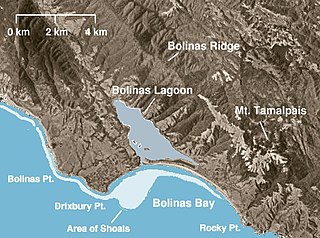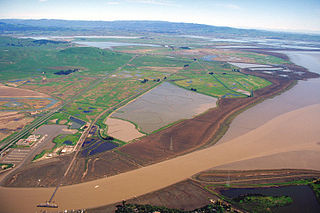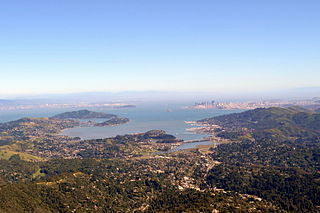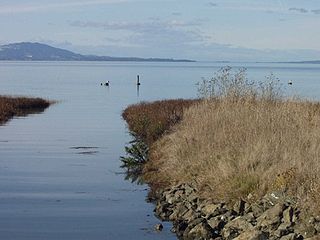This article needs additional citations for verification .(February 2016) (Learn how and when to remove this template message) |

Triangle Marsh is a wetland of the San Francisco Bay, situated at the base of Ring Mountain at the north end of the Tiburon Peninsula in Marin County, California. [1]
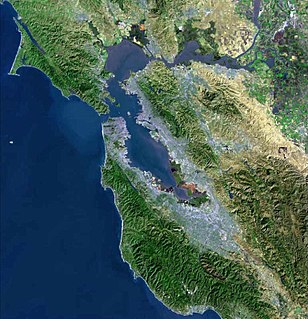
San Francisco Bay is a shallow estuary in the US state of California. It is surrounded by a contiguous region known as the San Francisco Bay Area, and is dominated by the large cities of San Jose, San Francisco and Oakland.

Ring Mountain is an elevated landform on the Tiburon Peninsula in Marin County, California. This mountain was named for George E. Ring, who served as a Marin County Supervisor from 1895 to 1903.

The Tiburon Peninsula, or simply "the Tiburon", is a region of Haiti encompassing most of Haiti's southern coast. It starts roughly at the southernmost of the Haiti-Dominican Republic border and extends westward near Cuba, forming a large headland. Four of Haiti's ten departments are located entirely within the region. They are the departments of Grand'Anse, Nippes, Sud, and Sud-Est. A large part of Ouest department is also located in the region, with the capital, Port-au-Prince serving as the line of demarcation between central Haiti and the south. The biological hot-spot of the Massif de la Hotte is located in the region in which various endemic species on the island originate.
Contents
Archaeological Pecked curvilinear nucleated petroglyphs, and recovery on Ring Mountain, hold significant evidence of Native American habitation and likely proof that early Miwok peoples exploited marine resources from Triangle Marsh. [2]
Archaeology, or archeology, is the study of human activity through the recovery and analysis of material culture. The archaeological record consists of artifacts, architecture, biofacts or ecofacts and cultural landscapes. Archaeology can be considered both a social science and a branch of the humanities. In North America archaeology is a sub-field of anthropology, while in Europe it is often viewed as either a discipline in its own right or a sub-field of other disciplines.

Pecked curvilinear nucleated, (PCN) in archaeology, is a form of prehistoric rock carving. The term was originally proposed by Teresa Miller and Reed Haslam in 1976 to describe a widespread type of rock carving in western North America. The form is characterized by a circular or oval groove element, which results in a raised center area. The form is quite prevalent in California and is applied to a number of Native American rock carving sites in this portion of the United States.

Petroglyphs are images created by removing part of a rock surface by incising, picking, carving, or abrading, as a form of rock art. Outside North America, scholars often use terms such as "carving", "engraving", or other descriptions of the technique to refer to such images. Petroglyphs are found worldwide, and are often associated with prehistoric peoples. The word comes from the Greek prefix petro-, from πέτρα petra meaning "stone", and γλύφω glýphō meaning "to carve", and was originally coined in French as pétroglyphe.
The 31-acre (130,000 m2) property is owned by the Marin branch of the National Audubon Society who restored upland and wetland habitats there with funding from a variety of sources. Federal endangered species, including the clapper rail and salt marsh harvest mouse, live in the Marsh.

The National Audubon Society (Audubon) is a non-profit environmental organization dedicated to conservation. Located in the United States and incorporated in 1905, Audubon is one of the oldest of such organizations in the world and uses science, education and grassroots advocacy to advance its conservation mission. It is named in honor of John James Audubon, a Franco-American ornithologist and naturalist who painted, cataloged, and described the birds of North America in his famous book Birds of America published in sections between 1827 and 1838.

The clapper rail is a member of the rail family, Rallidae. The taxonomy for this species is confusing and still being determined. The Ridgway's rail and the mangrove rail have been recently split. Furthermore, some taxonomists consider that the king rail and Aztec rail should be considered within this group, as those birds look similar and the birds are known to interbreed where they share territories.
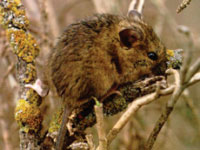
The salt marsh harvest mouse, also known as the red-bellied harvest mouse and sometimes called the saltmarsh harvest mouse, is an endangered rodent endemic to the San Francisco Bay Area salt marshes in California. There are two distinct subspecies, both endangered and listed together on federal and state endangered species lists. The northern subspecies is lighter in color and inhabits the northern marshes of the bay, and the southern subspecies lives in the East and South Bay marshes. They are both quite similar in appearance to their congener species, the [Western harvest mouse, R. megalotis], to which they are not closely related. Genetic studies of the northern subspecies have revealed that the salt marsh harvest mouse is most closely related to the plains harvest mouse, R. montanus,, which occurs now in the Midwest]. Its endangered designation is due to its limited range, historic decline in population and continuing threat of habitat loss due to development encroachment at the perimeter of San Francisco Bay.
